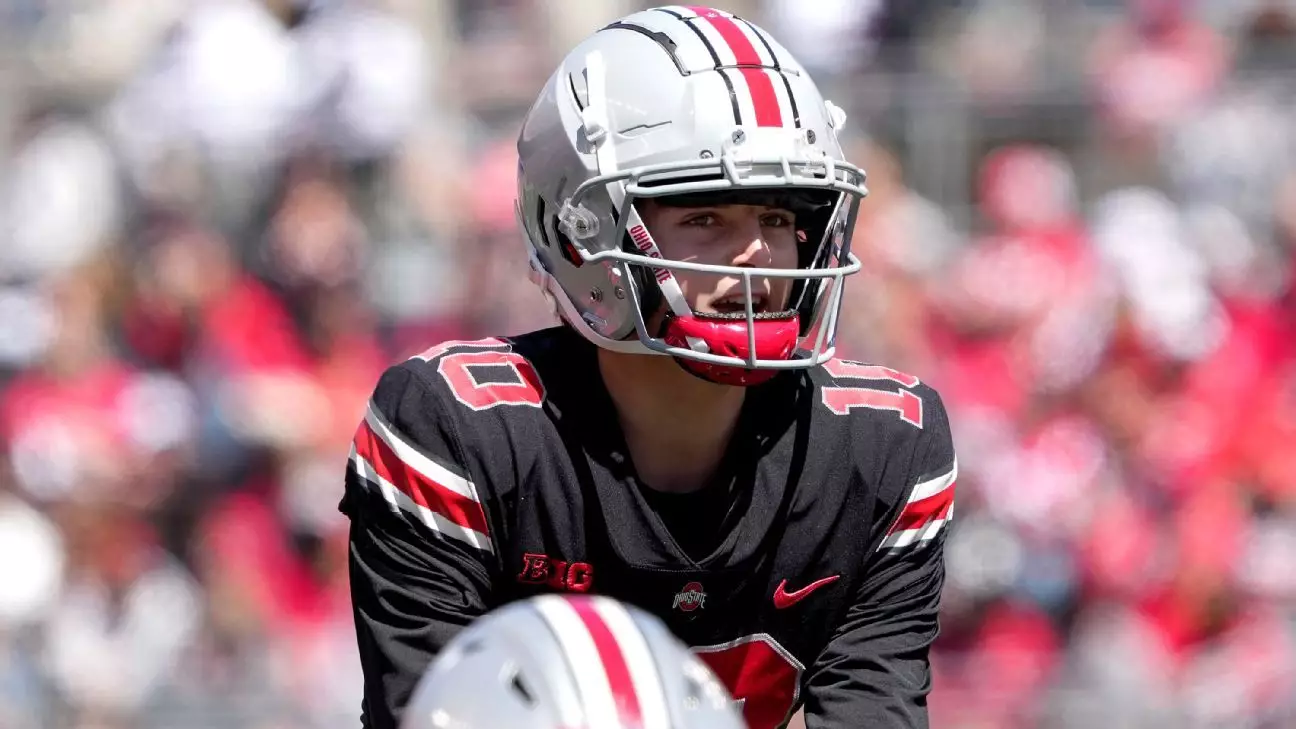Selecting a starting quarterback for a powerhouse like Ohio State, especially ahead of a storied showdown against Texas, appears straightforward on paper. Yet beneath the surface lies a complex web of doubts, competing interests, and strategic ambiguity that can jeopardize the Buckeyes’ season. Coach Ryan Day’s announcement—favoring Julian Sayin over Lincoln Kienholz—sounds decisive, but masks underlying vulnerabilities that could unravel Ohio State’s plans. It’s tempting to see this choice as a clear-cut victory for consistency, but a critical analysis reveals that this decision might be built on shakier foundations than apparent, risking a cycle of overconfidence and underperformance.
Ohio State rightly emphasizes recent performance metrics, but these do little to dispel the uncertainty surrounding Sayin’s limited game experience. Just four appearances—totally 27 snaps—offer a narrow window into his actual readiness for such a high-profile clash. Meanwhile, Kienholz’s absence from game action since last year’s Cotton Bowl leaves questions about his current development, despite evident athletic talent. The narrative of “growth over six months” is comforting, but in the brutal realities of college football, such growth may not translate into the clutch execution necessary against Texas’s formidable defense. Confidence in a player’s potential can often overshadow actual readiness, and this judgment risks mistaken priorities.
Risks of Overconfidence and the Myth of Consistency
Dismissing Kienholz’s contributions and potential in favor of Sayin’s recent surge raises serious concerns about short-termism. Day’s focus on “consistency” as a decisive factor may be a double-edged sword, especially when the margin between success and failure in college football is razor-thin. A quarterback’s ability to withstand pressure, adapt on the fly, and execute with poise under duress is often not reflected in practice reps or even limited game stats. Relying heavily on recent practice performance might ignore deeper issues—mental resilience, in-game decision-making, and leadership qualities—that routinely separate good quarterbacks from great ones in high-stakes moments.
Moreover, the notion that Kienholz will serve as a backup and “know he’ll play this year” implies a level of confidence that might not entirely align with reality. Backup quarterbacks often carry a burden of unpredictable pressure—they must be prepared to step into a maelstrom at any moment, often without warning. To assume that Kienholz’s “good energy” and practice performance automatically position him to assume a backup role, without actual game reps, can be dangerously naive. Such assumptions risk exposing Ohio State to avoidable pitfalls if Sayin falters or struggles to adapt against Texas’s aggressive defense.
The Deception of Institutional Confidence and the Need for Genuine Competence
What truly underpins Ohio State’s strategic confidence is a belief in institutional strength—advanced recruiting, player development, and coaching prowess. But the veneer of perfection often conceals cracks. The decision to prioritize recent practice signals possibility that internal competition was less about merit and more about managing narratives. This approach elevates a player based on hype and recent achievements rather than proven clutch performance. In a broader context, the college football ecosystem—like many sports—sometimes prioritizes optics over genuine merit. Ohio State’s choice may be less about identifying the best quarterback for Texas and more about maintaining a cohesive, confident image to supporters and recruits.
Furthermore, this consistency emphasis subtly shifts responsibility onto young players, underestimating the enormous pressure of facing a team like Texas. No matter the touted “growth,” college quarterbacks are often dependent on their offensive line, receivers, and overall team execution. The decision mainly highlights how institutions tend to romanticize individual heroism—believing that a relatively inexperienced player can carry the team without recognizing the collective nature of football. By overlooking these nuanced vulnerabilities, Ohio State exposes itself to the dangerous illusion that talent alone can guarantee victory.
The Center-Left Reality of College Football Strategy
From a centrist, liberal perspective, the emphasis should be on fostering genuine competition and equitable development rather than resting on recent performances or hype. It’s about recognizing that every athlete’s potential is a product of sustained support, realistic evaluation, and strategic patience. Ohio State’s decision, seemingly driven by need for immediate results, risks undermining a culture of genuine meritocracy—particularly for a symbolically important game like the opener against Texas.
In a broader sense, the obsession with quick fixes and immediate wins masks larger issues of player welfare, mental health, and long-term development. Choosing a quarterback over a seemingly more proven but less flashy alternative might secure short-term tactical advantage but could stifle the deeper growth many of these young athletes need. It’s this center-left ideology that champions the importance of nurturing talent responsibly, creating environments where failure is an instructive, rather than stigmatized part of maturation.
Ohio State’s decision on their quarterback signals more than just tactical planning; it reflects a broader cultural tendency to prioritize immediate success over sustainable development. In doing so, the Buckeyes risk setting a precedent where perceived confidence trumps genuine competence, placing their season—and perhaps their reputation—on a fragile foundation.

